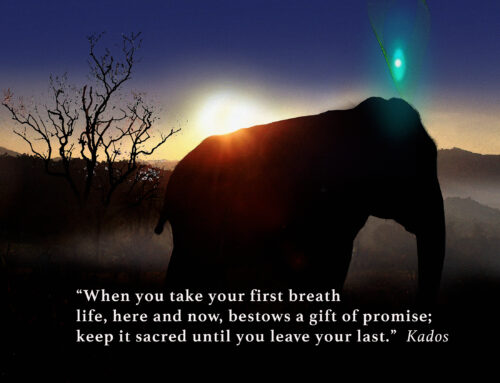MORE NOTES ON THE ELEPHANT
Recently I’ve been in contact with Alyne Fortgang in Seattle, Washington, USA. She is cofounder of a group of citizens diligently trying to convince the city’s zoo, WoodLand Park, to free its elephant captives so they can be moved to a larger, more humane sanctuary. It’s a noble endeavor and I wish them every success though I am all too aware of the difficulties that lie ahead of them.
I live in southeast Asia where for millennia elephants have been made captive, their spirits broken. Historically, they were trained as war animals but never to much success. The elephants would often panic and stampede their own armies. More successfully, they were used to carry the massive teak logs from the tropical forests of Asia. Ironically, at the same time, elephants were, and still are, revered as the Buddha reincarnate.
The world’s demand for exotic woods have nearly depleted these ancient forests which were home to hundreds of thousands of wild elephants. Today there are less than 3000 wild elephants in Thailand. There are approximately 2000 captive elephants that had been primarily used in the logging industry. But there has been a ban on logging for several decades and many of these elephants and their mahouts have had to turn to tourism for survival.
Buses and buses of tourists from the United States, Europe, Japan, and China pour into these ever growing elephant camps which have become little more than circuses ‘in situ’ where elephants are trained to play soccer, musical instruments, paint paintings then stand around waiting for handouts from the tourists. Not only is this terribly demeaning to the spirit of the elephant, it speaks volumes about the depletion of our own spirit.
WE DON’T NEED TO TRAIN ELEPHANTS, WE NEED TO TRAIN TOURISTS!
The people who own these camps are proud business people—no different from people who own automobile manufacturing companies, people who design and build palatial homes or the people who operate circuses and zoos. They hire a lot of folks. They are charged with making a profit and satisfying their stockholders. It is, as it has always been, a question of supply and demand.
POTENTIAL SCENARIO:
A group of very conscientious people buy a few thousand rai (100 rai = 39.5 acres) of land near the most popular elephant camp in all of Asia. All captive elephants from any place they can be gotten are brought into this ‘Elephant Eden Sanctuary.’ Because these are captive elephants whose original spirit has once been broken and now are bonded to humans, they must be kept within their hierarchal construct with humans. They now depend upon the presence of human keepers. But here they do not play soccer. They do not dance, ring bells, bow, or any of those things we humans do. They do not carry humans on their backs. They are simply allowed to plod around doing what elephants prefer to do, one of which is to eat a great deal—they have to. This then is a kind of eco-tourism. Tourist pay to experience these magnificent creatures in as close to their natural environment as is possible.
I have no doubt that if such a place were in place, that if tourists could be turned toward something much more educational rather than entertainment, they would to spend their dollars in this fashion; the other places would readily follow suit. Believe me, just standing close to an elephant is an extraordinary experience. Regrettably, tourists are much harder to train than elephants, principally because elephants have a clearer understanding of what they need and what they don’t need. Humans do not.
Zoos and any institution of animal entertainment represent terribly archaic institutions. Why we still have them as they now exist is beyond belief, except for the element of money driven by supply and demand.
Any child old enough to read and grasp the most fundamental issues about species diversification and the importance of species sustainability will learn more from books and film documentaries of animals existing in their natural habitat than they could possibly learn from watching any creature kept in a cage or in limited confinement. And there is evidence to support that, in fact, most people who visit zoos come away feeling somewhat diminished and saddened by the experience. So why do we have them?
What children do not learn is the significant abuse and cruelty that occurs to many elephants in captivity. If you are a parent, an uncle, an aunt, a sister, brother or teacher, are you willing to tell a young child that the mother of that adorable elephant before her or him might possibly have been murdered by humans simply to capture the baby elephant? And for whose benefit? Or that elephants are routinely beaten to keep them docile and willing to perform for humans? Or of the traditional brutal process of breaking the spirit of an elephant, initially separating it from its captive mother?
OK. Let’s try another potential scenario;
THE NEW WORLD ZOO
News flash: Seattle, Washington. On behalf of the citizens of Seattle, Washington, the Woodland Park Zoo has announced plans to begin the processes of converting itself to the New World Zoo. Beginning with the elephants first, captive animals will be transferred to facilities known as ‘species sanctuaries’ where they live out the rest of their lives in protected areas that more closely resemble their native habitats. Here, under these conditions, more efficient research can be carried out and closely monitored through multi-national scientific organizations.
The Park itself will begin construction on the first New World Zoo Media Center which will create several large theaters designed to implement extremely advanced media technology. Drawing upon some of the most creative minds in filmmaking, animation and virtual reality, adults and children alike will have the opportunities to experience the world literally through the eyes of other species. Other smaller theaters will house additional interactive libraries which will be connected to local school libraries.
It is estimated that within a decade the New World Zoo will be generating greater profits than it did before, offering substantially more positive benefits to the community through education as well as collectively supporting ‘species’ sanctuaries’ throughout the world and participating in the protection of species habitats.
I offered this concept to a friend the other day. He politely smiled and said. “Galen, something like that is simply a dream.”
Is it a dream?
Yes.
Is it possible?
Yes.





